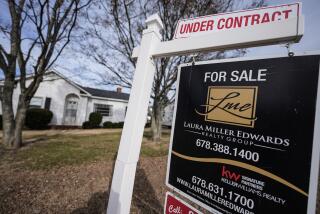Seller Benefits From Realistic Pricing
- Share via
Hot market. Cool market. Lukewarm market.
All markets have one element in common: homes that beg for buyers.
In most cases, you don’t need someone with the gray matter of a nuclear physicist to determine the barrier to sale. The price tag dangling from the home simply frightens prospects away.
“Sixty to 70% of the time, the issue is price,” said Peter G. Miller, the author of several books on real estate.
Ironically, even in neighborhoods where sellers are in control and properties are attracting multiple offers, an overpriced house may languish unsold for a long time, according to Alan Turetsky, the broker-owner of two Re / Max Realty offices.
Why? Because by overpricing, you keep your property off the radar screen of a large number of genuine prospects. These days, most buyers know rather precisely what they can afford because they’ve contacted a mortgage lender before hunting for a house. So your overpriced listing may not even turn up on a computer search done for them.
“Overcharge and a certain segment of the market will never see your house,” Turetsky said.
What’s the cause of overpricing? Often, homeowners will try to stretch for a price slightly higher than the listing agent suggests.
Typically, it’s no more than 5% over the recommended range, but that’s enough to seriously hurt the seller’s chances, Turetsky said.
You may have time to “test the market” with an overpriced house, especially if you’re making a discretionary move and aren’t pinched for time. But homes that become stale generally fetch less than those priced right from the outset. It’s a virtual law of real estate that buyers become suspicious of shopworn property.
Here are five pointers for sellers of homes that have lingered longer on the market:
No. 1: Don’t automatically assume that a high price is the issue.
Kathy Lewis, a Coldwell Banker broker-associate who has sold property for 21 years, said many buyers now demand homes in near-perfect “move-in” condition.
That means a place that needs updating or other work from the new owner is at a serious competitive disadvantage in the marketplace even if it’s priced low to reflect its condition.
The increasing prevalence of dual-income households means fewer people are willing--or able--to stay home and wait for a plumber, electrician, painter or remodeler, Lewis said.
“Professional people are not willing to take off time from work to replace that harvest-gold stove or those green shag carpets from the ‘70s. Nor do they want to give up work time to modernize an outdated bathroom,” she said.
The chronic time shortage faced by many means that a savvy seller will arrange for important cosmetic renovations prior to moving, Lewis said. Of course, you’re busy, too, but your real estate agent or her assistant can often help by meeting a contractor or delivery person when you’re not home.
No. 2: Diagnose a problem early through a brokers’ open house.
Lewis seeks to schedule two open houses for every home she lists within 14 days of the property going on the market. One is the typical open house in which anyone from the public can come through. The other is a “brokers’ open” arranged to expose the property to other agents in the community.
Of the two, Lewis considers the brokers’ open a far more effective tool for picking up feedback on factors that could stall the sale.
Other agents will tell your agent whether the home has an unsavory smell to it, a cluttered family room that shows badly, or a carpet with an unflattering hue. Want the other agents to be especially blunt in itemizing their objections?
Then be sure your listing agent has them fill out anonymous questionnaires before they leave the brokers’ open. Often, people are more candid when their names aren’t shown.
No. 3: Look across the field at the opposing team.
There’s almost always some sort of competition for homes in your price range in the same general area. To find out what you’re up against, Lewis suggests you look at nearby properties priced within 10% to 15% of your own, including brand-new homes.
You may be surprised to learn how much more a buyer could get if he bought one of the rival homes for about the same price. Certainly, many buyers prefer the freshness of new construction.
Knowing the competition is an essential element in the home-selling process, Lewis said.
You don’t always have to see the interior of rival homes, though you can readily do so during a public open house. If you’re short on time, it’s still helpful to ask your agent for a list of similarly priced homes you can drive by.
No. 4: Invite in friends, relatives and neighbors for a home-carping session.
Are you having problems garnering bidders for your property? Then it could be time for a party. Bring out the chips, dips and sodas and ask your associates to come by for a serious look at your home.
As they sip and crunch, ask them to give you five reasons why they think your home is not selling. Include the condition, price and terms of sale as factors. (You could, for instance, be discouraging prospects by insisting that all the attractive lighting fixtures be removed before the house conveys.) Tell your associates you want the whole truth.
No. 5: Play “Truth or Consequences.”
Have you already replaced the harvest-gold stove and the green shag carpets? Have you rectified everything else outsiders said is wrong with your place?
Yet has your house still gone unsold for more than 20 days beyond the average listing time in your community?
Then it’s time to remember the long-running TV game show called “Truth or Consequences.”
Either reduce your price to a realistic level or accept the fact that you’ll have to continue waiting and may get less money next week than if you make your tough price-cutting decision this week, said Lewis, of Coldwell Banker. “Take off those rose-colored glasses,” she said.
Distributed by Universal Press Syndicate.
More to Read
Inside the business of entertainment
The Wide Shot brings you news, analysis and insights on everything from streaming wars to production — and what it all means for the future.
You may occasionally receive promotional content from the Los Angeles Times.










